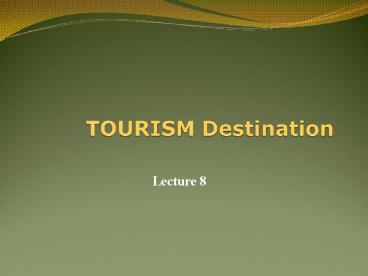TOURISM Destination - PowerPoint PPT Presentation
1 / 12
Title:
TOURISM Destination
Description:
Lecture 8 WHAT IS TOURISM Destination ? A destination is the primary product offered in the travel and tourism industry. A destination can obviously be ... – PowerPoint PPT presentation
Number of Views:4827
Avg rating:3.0/5.0
Title: TOURISM Destination
1
TOURISM Destination
- Lecture 8
2
WHAT IS TOURISM Destination? A destination is
the primary product offered in the travel and
tourism industry. A destination can obviously be
defined by its geographical location and
boundaries. All of the activities, attractions,
hotels, restaurants, and other visitor services
located within those boundaries are considered to
be part of that destination. A destination can
be a single business, such as a theme
parkDisneyland in Anaheim, California. A
destination can also be a city, such as
Alexandria.
3
Framework for the analysis of tourism
destinations (the five As of a destination)
4
CHALLENGES FOR DESTINATION MARKETING
ORGANIZATIONS
5
- Strategic management and marketing objectives for
destinations - Enhance the long term prosperity of local people.
- Delight visitors by maximizing their satisfaction
- Maximize profitability of local enterprises and
maximize multiplier effects - Optimize tourism impacts by ensuring a
sustainable balance between economic benefits and
socio-cultural and environmental costs
6
Type of Destination and Reason for Visiting
Type of Destination Reason for Visiting
Urban Business, Leisure, Education, Religion, Health, Sports Organisations.
Seaside (Resort) Summer holidays, Relaxation.
Alpine Leisure, Winter sports, Discover unexplored nature.
Rural Back-to-nature trend, Familiarization with agriculture.
Authentic (Third World) countries Authentic experience, Limited tourism development, Adventure.
Unique-Exotic-Exclusive Dream Vacations.
7
Destination Management Organisations
(D.M.O.s) Middleton (2001, p.327) describes
Destination Management Organisations as the
marketing side of a National Tourism Organisation
or else National Tourism Administration,
responsible for the overall marketing of
countries as tourist destinations. In fact,
Destination Management Organisations (D.M.O.s)
have the responsibility for the planning and
marketing of areas mainly on a local or regional
level. Organisations responsible for a country as
a destination are called National Tourism
Organisations (N.T.O.s)
8
National Tourism Organisations (N.T.O.s) Kotler
el al. (1999, p.667) define National Tourism
Organisations as a central tourist agency, which
may be public, quasi-public, non-profit or
private. However, the majority of N.T.O.s
worldwide are part of the public sector and
therefore, carry out public policy in accordance
to the goals of the government (Coltman, 1989).
N.T.Os cannot be replaced by private parties,
because of the social and economic benefits
tourism offers in the entire country.
9
- A National Tourist Organization ought to be in
charge of the following functions - Research
- Information and promotion within the country
- Regularization of standards of lodgings and
restaurants - Control of activities of private travel agencies
- Publicity overseas
- International relations
- Development of selected tourist areas
- Overall tourism policy and promotion
10
- Key components of destination competitiveness
- Core resources and attractors physiography/climat
e culture/history market ties mix of
activities special events entertainment
superstructure - Supporting factors and resources infrastructure
accessibility facilitating resources
hospitality enterprise - Destination management marketing fi nance and
venture capital organization human resource
development information/research quality of
service visitor management resource stewardship - Destination policy, planning, development system
defi nition philosophy vision audit
positioning competitive/collaborative analysis
monitoring and evaluation - Qualifying and amplifying determinants location
interdependencies safety/security
awareness/image/brand cost/value
11
- Role of Image in Destination Choice
- Travelers images of destinations play an
important role in destination choice. - Image differentiates tourist destinations from
each other and is an integral and influential
part of the travelers decision process (Baloglu
and Brinberg, 1997). - One of the reasons is the intangibility of
destinations. They cannot be sampled or tested
out before the purchase like most products.
12
- Destination Image
- Definition of Destination Image
- The sum of beliefs, ideas, and impressions that a
person has of a destination - Components of Destination Image
- Organic Images formed by individuals themselves
through such things as past experiences with
destinations, and through unbiased sources of
information (e.g., news reports, movies,
newspaper articles, etc.). - Induced Images created through information
received from external sources, including
destination advertising and promotion.































